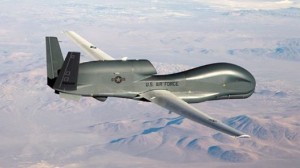No, let me correct that statement, this is fearful news.
A U.S. military drone from Tyndall AFB believed to be a QF-4 exploded in flames and a black cloud of smoke.
The incident shut down Highway 98 west of Panama City in the Florida Panhandle.
Eyewitnesses say the drone “came in hard and fast” before it crashed.
Reportedly, the drone was carrying a small, self-destruct charge and “had to be destroyed for safety considerations during its return to base following a routine operation.”
Just last week, the military had to push a “destroy” button on another drone over the Gulf of Mexico.
So, what is going on?
Previously, a drone has gone down while monitoring piracy off the East Africa; Iran claims it shot down an RQ-170 drone, but the U.S. says Iran was not responsible for the drone’s destruction.
There’s been speculation that a computer virus is infecting drones and/or drone control systems.
A source supposedly familiar with the infection has been quoted as saying, “We keep wiping it off, and it keeps coming back. — We think it’s benign, but we just don’t know.”
So, is someone (or country) infecting the drones only to destroy them, or at least get them to deviate from course, so protocol mandates destruction?
Is someone (or country) actually trying to control the drones and use them against targets of choice or capture drones, land them and load them with warheads?
The Air Force declined to comment directly on the virus.
Lt. Col. Tadd Sholtis is a spokesman for Air Combat Command which oversees drones and other AF tactical aircraft. He said, “We generally do not discuss specific vulnerabilities, threats, or responses to our computer networks, since that helps people looking to exploit or attack our systems to refine their approach …We invest a lot in protecting and monitoring our systems to counter threats and ensure security, which includes a comprehensive response to viruses, worms, and other malware we discover.
On top of all this, a recent report claims that a significant number of operators controlling drones in war zones are suffering, “clinical distress … anxiety, depression or stress severe enough to affect an operator’s job performance.”
There’s no doubt that drones can be effective in war, not risking pilots when unmanned craft can do the job.
Drones have been used to monitor our borders, and the FBI has admitted using drones in some surveillance programs over U.S. soil.
In some cases, state and local police want drones to spot drug traffic, search for missing children, provide intel to SWAT teams; environmentalists want them to count endangered species; oil companies want them to survey pipelines.
It’s estimated government and commercial use of drones could be in the 89 billion dollar range in the next decade.
Congress has directed the FAA to come up with safety regulations clearing the way for routine domestic use of unmanned aircraft within the next three years.
Based on all these interests, our skies could be filled with drones … like a swarm of mosquitoes.
Maybe the drones will perform as intended.
Maybe the drones will be violating civil rights. A recent survey found 1/3 of Americans questioned fear the drones will be unconstitutionally invading their privacy.
Maybe the drones will be out of control or under villainous control … crashing into planes, office buildings, schools.
Look! In the sky! It’s a bird, a plane … a drone!
Do you smile and say, good?
Do you run and hide?
Do you … run for cover?


